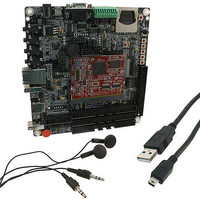OM13001,598 NXP Semiconductors, OM13001,598 Datasheet - Page 65

OM13001,598
Manufacturer Part Number
OM13001,598
Description
EA LPC177X/8X EVAL BOARD
Manufacturer
NXP Semiconductors
Series
-r
Type
MCUr
Specifications of OM13001,598
Contents
Board, Cable, Headphones, Registration Card
Lead Free Status / Rohs Status
Lead free / RoHS Compliant
For Use With/related Products
LPC1788
Other names
568-6707
- Current page: 65 of 117
- Download datasheet (2Mb)
NXP Semiconductors
LPC178X_7X
Objective data sheet
7.33.4.4 Deep power-down mode
7.33.4.5 Wake-up Interrupt Controller (WIC)
7.33.5 Peripheral power control
7.33.6 Power domains
The Deep power-down mode can only be entered from the RTC block. In Deep
power-down mode, power is shut off to the entire chip with the exception of the RTC
module and the RESET pin.
To optimize power conservation, the user has the additional option of turning off or
retaining power to the 32 kHz oscillator. It is also possible to use external circuitry to turn
off power to the on-chip regulator via the V
V
device operation can be restarted.
The LPC178x/7x can wake up from Deep power-down mode via the RESET pin or an
alarm match event of the RTC.
The WIC allows the CPU to automatically wake up from any enabled priority interrupt that
can occur while the clocks are stopped in Deep sleep, Power-down, and Deep
power-down modes.
The WIC works in connection with the Nested Vectored Interrupt Controller (NVIC). When
the CPU enters Deep sleep, Power-down, or Deep power-down mode, the NVIC sends a
mask of the current interrupt situation to the WIC.This mask includes all of the interrupts
that are both enabled and of sufficient priority to be serviced immediately. With this
information, the WIC simply notices when one of the interrupts has occurred and then it
wakes up the CPU.
The WIC eliminates the need to periodically wake up the CPU and poll the interrupts
resulting in additional power savings.
A power control for peripherals feature allows individual peripherals to be turned off if they
are not needed in the application, resulting in additional power savings.
The LPC178x/7x provide two independent power domains that allow the bulk of the
device to have power removed while maintaining operation of the RTC and the backup
registers.
On the LPC178x/7x, I/O pads are powered by the 3.3 V (V
V
CPU and most of the peripherals.
Depending on the LPC178x/7x application, a design can use two power options to
manage power consumption.
The first option assumes that power consumption is not a concern and the design ties the
V
supply for both pads, the CPU, and peripherals. While this solution is simple, it does not
support powering down the I/O pad ring “on the fly” while keeping the CPU and
peripherals alive.
DD(3V3)
DD(REG)(3V3)
DD(3V3)
pins after entering Deep Power-down mode. Power must be restored before
and V
pin powers the on-chip voltage regulator which in turn provides power to the
DD(REG)(3V3)
All information provided in this document is subject to legal disclaimers.
Rev. 2 — 27 May 2011
pins together. This approach requires only one 3.3 V power
DD(REG)(3V3)
32-bit ARM Cortex-M3 microcontroller
pins and/or the I/O power via the
DD(3V3)
LPC178x/7x
) pins, while the
© NXP B.V. 2011. All rights reserved.
65 of 117
Related parts for OM13001,598
Image
Part Number
Description
Manufacturer
Datasheet
Request
R
Part Number:
Description:
NXP Semiconductors designed the LPC2420/2460 microcontroller around a 16-bit/32-bitARM7TDMI-S CPU core with real-time debug interfaces that include both JTAG andembedded trace
Manufacturer:
NXP Semiconductors
Datasheet:

Part Number:
Description:
NXP Semiconductors designed the LPC2458 microcontroller around a 16-bit/32-bitARM7TDMI-S CPU core with real-time debug interfaces that include both JTAG andembedded trace
Manufacturer:
NXP Semiconductors
Datasheet:
Part Number:
Description:
NXP Semiconductors designed the LPC2468 microcontroller around a 16-bit/32-bitARM7TDMI-S CPU core with real-time debug interfaces that include both JTAG andembedded trace
Manufacturer:
NXP Semiconductors
Datasheet:
Part Number:
Description:
NXP Semiconductors designed the LPC2470 microcontroller, powered by theARM7TDMI-S core, to be a highly integrated microcontroller for a wide range ofapplications that require advanced communications and high quality graphic displays
Manufacturer:
NXP Semiconductors
Datasheet:
Part Number:
Description:
NXP Semiconductors designed the LPC2478 microcontroller, powered by theARM7TDMI-S core, to be a highly integrated microcontroller for a wide range ofapplications that require advanced communications and high quality graphic displays
Manufacturer:
NXP Semiconductors
Datasheet:
Part Number:
Description:
The Philips Semiconductors XA (eXtended Architecture) family of 16-bit single-chip microcontrollers is powerful enough to easily handle the requirements of high performance embedded applications, yet inexpensive enough to compete in the market for hi
Manufacturer:
NXP Semiconductors
Datasheet:

Part Number:
Description:
The Philips Semiconductors XA (eXtended Architecture) family of 16-bit single-chip microcontrollers is powerful enough to easily handle the requirements of high performance embedded applications, yet inexpensive enough to compete in the market for hi
Manufacturer:
NXP Semiconductors
Datasheet:
Part Number:
Description:
The XA-S3 device is a member of Philips Semiconductors? XA(eXtended Architecture) family of high performance 16-bitsingle-chip microcontrollers
Manufacturer:
NXP Semiconductors
Datasheet:

Part Number:
Description:
The NXP BlueStreak LH75401/LH75411 family consists of two low-cost 16/32-bit System-on-Chip (SoC) devices
Manufacturer:
NXP Semiconductors
Datasheet:

Part Number:
Description:
The NXP LPC3130/3131 combine an 180 MHz ARM926EJ-S CPU core, high-speed USB2
Manufacturer:
NXP Semiconductors
Datasheet:

Part Number:
Description:
The NXP LPC3141 combine a 270 MHz ARM926EJ-S CPU core, High-speed USB 2
Manufacturer:
NXP Semiconductors

Part Number:
Description:
The NXP LPC3143 combine a 270 MHz ARM926EJ-S CPU core, High-speed USB 2
Manufacturer:
NXP Semiconductors

Part Number:
Description:
The NXP LPC3152 combines an 180 MHz ARM926EJ-S CPU core, High-speed USB 2
Manufacturer:
NXP Semiconductors

Part Number:
Description:
The NXP LPC3154 combines an 180 MHz ARM926EJ-S CPU core, High-speed USB 2
Manufacturer:
NXP Semiconductors










